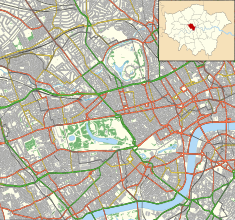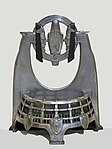
Sir Edwin Landseer Lutyens was an English architect known for imaginatively adapting traditional architectural styles to the requirements of his era. He designed many English country houses, war memorials and public buildings. In his biography, the writer Christopher Hussey wrote, "In his lifetime (Lutyens) was widely held to be our greatest architect since Wren if not, as many maintained, his superior". The architectural historian Gavin Stamp described him as "surely the greatest British architect of the twentieth century".
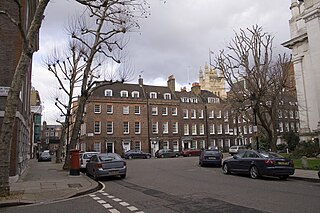
Smith Square is a square in Westminster, London, 250 metres south-southwest of the Palace of Westminster. Most of its garden interior is filled by St John's, Smith Square, a Baroque surplus church, the inside of which has been converted to a concert hall. Most adjoining buildings are offices, with the focus on organisations lobbying or serving the government. In the mid-20th century, the square hosted the headquarters of the two largest parties of British politics, and it is now hosts much of the Department for Environment, Food and Rural Affairs and the Local Government Association. It has a pedestrian or mixed approach to the four sides and another approach to the north.
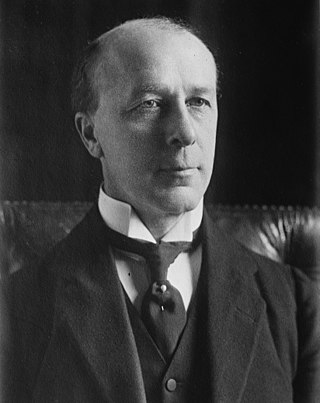
Reginald McKenna was a British banker and Liberal politician. His first Cabinet post under Henry Campbell-Bannerman was as President of the Board of Education, after which he served as First Lord of the Admiralty. His most important roles were as Home Secretary and Chancellor of the Exchequer during the premiership of H. H. Asquith. He was studious and meticulous, noted for his attention to detail, but also for being bureaucratic and partisan.

Henry Ludwig Mond, 2nd Baron Melchett was a British politician, industrialist and financier.

Charles Sargeant Jagger was a British sculptor who, following active service in the First World War, sculpted many works on the theme of war. He is best known for his war memorials, especially the Royal Artillery Memorial at Hyde Park Corner and the Great Western Railway War Memorial in Paddington Railway Station. He also designed several other monuments around Britain and other parts of the world.

Lowndes Square is a residential garden square at the north-west end of Belgravia, London, SW1. It is formed of archetypal grand terraces of light stucco houses, cream or white. The length of the central rectangular garden is parallel with Sloane Street to the west; visible from the north-west corner is a corner of the Harvey Nichols store, beyond which is Knightsbridge tube station. Ecclesiastically, it remains in a northern projection of one of the parishes of Chelsea, except its east side, which is in the very small parish of St Paul, Knightsbridge, a division which is mirrored secularly by the boundaries of two London Boroughs.

The Jaipur Column is a monumental column in the middle of the courtyard in front of Rashtrapati Bhavan, the presidential residence in New Delhi, Delhi, India. In 1912 Madho Singh II, the Maharaja of Jaipur, offered to sponsor its construction to commemorate the 1911 Delhi Durbar and the transfer of the capital of India from Calcutta to New Delhi.

Heathcote is a Neoclassical-style villa in Ilkley, West Yorkshire, England. Designed by architect Edwin Lutyens, it was his first comprehensive use of that style, making it the precursor of his later public buildings in Edwardian Baroque style and those of New Delhi. It was completed in 1908.
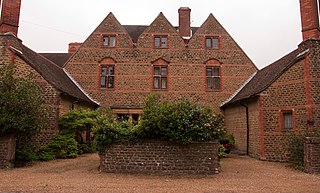
Tigbourne Court is an Arts and Crafts style country house in Wormley, Surrey, England, 1 mile (1.6 km) south of Witley. It was designed by architect Edwin Lutyens, using a mixture of 17th-century style vernacular architecture and classical elements, and has been called "probably his best" building, for its architectural geometry, wit and texture. It was completed in 1901. English Heritage have designated it a Grade I listed building.
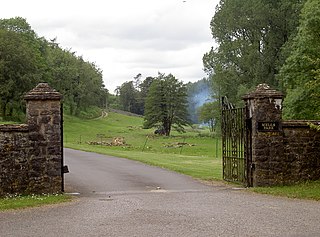
Mells Park is a country estate of 140 hectares near Mells, Somerset, England. It originated as a 17th-century deer park, probably created by the Horner family, who had been the owners of Mells Manor from 1543. The Horners expanded the park and planted extensive woodlands, resulting in a large collection of mature trees, especially 18th-century plantings of oak, lime and beech. The park is Grade II listed in the National Register of Historic Parks and Gardens. It contains Park House, also known as Mells Park House, a Grade II* listed building, built in 1925 in neoclassical style by the architect Edwin Lutyens, replacing an 18th-century house of the same name. It is c. 1 mile (1.6 km) west of Mells Manor House, which does not lie within the park.

Marshcourt, also spelled Marsh Court, is an Arts and Crafts style country house in Marsh Court, near Stockbridge, Hampshire, England. It is constructed from quarried chalk. Designed and built by architect Edwin Lutyens between 1901 and 1905, it is a Grade I listed building. The gardens, designed by Lutyens and Gertrude Jekyll, are Grade II* listed in the National Register of Historic Parks and Gardens.
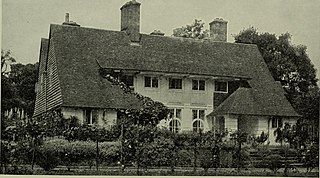
Homewood is an Arts and Crafts style country house in Knebworth, Hertfordshire, England. Designed and built by architect Edwin Lutyens around 1900–3, using a mixture of vernacular and Neo-Georgian architecture, it is a Grade II* listed building. The house was one of Lutyens' first experiments in the addition of classical features to his previously vernacular style, and the introduction of symmetry into his plans. The gardens, also designed by Lutyens, are Grade II listed in the National Register of Historic Parks and Gardens.

Frances Jane Horner, Lady Horner was a British hostess, member of the Souls social group, and a patron of the arts. She was depicted several times by Edward Burne-Jones, and commissioned works by Edwin Lutyens, Eric Gill, and William Nicholson. She was the impetus for Norah Lindsay beginning a paid career as a garden designer as her garden at Mells Manor was designed by Lindsay.

New Place, Shirrell Heath, Shedfield, Hampshire, England, is a former country house, now a hotel, designed by Edwin Lutyens. It is a Grade I listed building.

Tranarossan House is an early 20th century building in Carrigart, County Donegal, Ireland. It was designed by Edwin Lutyens for Lucy Phillimore, wife of Robert Charles Phillimore. The Phillimores had bought the land on the Donegal coast in the 1890s and commissioned Lutyens to build a holiday home. The house is little documented and is not recorded in most studies of Lutyens. After her husband's death, Lucy Phillimore handed the house over to An Óige, the Irish Youth Hostel Association, in 1937. It still operates as An Óige's most northerly hostel and is a protected structure.
Costelloe Lodge is an early 20th century building in Casla, County Galway, Ireland. It was designed by Edwin Lutyens for J. Bruce Ismay, chairman of the White Star Line, after Ismay's original fishing lodge was burnt out in an IRA attack in 1922. Ismay had bought the house a year after the Titanic disaster and, largely ostracised by society, spent much time at the lodge until his death in 1937. After the attack on the house Ismay engaged Lutyens to undertake a major reconstruction. The garden was laid out by Lutyens’ long-time collaborator Gertrude Jekyll. Little documented and unreferenced in the major studies of Lutyens, the lodge remains privately owned and is a protected structure.

Heywood House Gardens, generally Heywood Gardens, form the grounds of a now-vanished house in County Laois, Ireland. The estate was developed in the late 18th century by Michael Frederick Trench, a politician, landowner and architect. He built a substantial house and laid out an extensive park, under the direction of James Gandon. In the early 20th century, Heywood was owned by Sir Hutcheson Poë who commissioned Edwin Lutyens to develop the gardens immediately surrounding the house. Lutyens engaged his long-time collaborator Gertrude Jekyll to undertake the planting. The house was demolished after a fire in 1950 and the gardens are now in the care of the Office of Public Works.

The Midland Bank, 27-35 Poultry stands on Poultry in the City of London. It was built between 1924 and 1929 as the headquarters offices of the Midland Bank. The architect was Edwin Lutyens. A Grade I listed building, its Historic England record describes it as one of Lutyens' "finest urban buildings". It is now a hotel, The Ned, named in Lutyens' honour.

Berrydown Court is a late 19th-century country house, on the B3400 road between the villages of Ashe and Overton in Hampshire, England. The house was built in 1897-1898 and was designed by Edwin Lutyens. Berrydown is a Grade I listed building, and its entrance lodge and boundary walls are also listed at Grade I.

